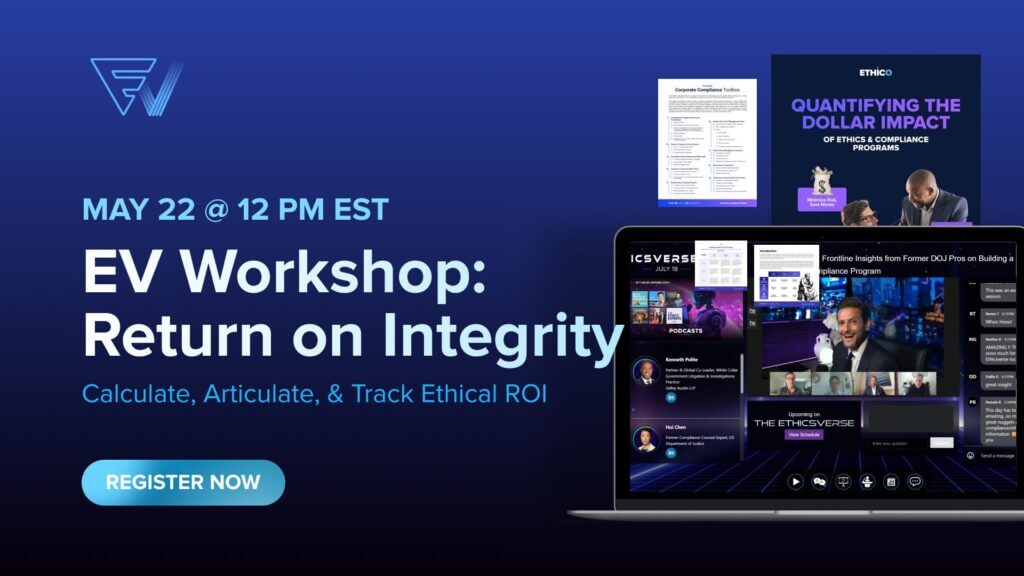EV Healthcare: Cohesive Board Reporting for E&C and HR 🏥✍️


Full Episode Available
WATCH ON-DEMANDIn the boardroom, the most valuable currency isn’t data but the meaning you extract from it. Board members don’t need more information—they need the clarity that comes from expert interpretation of complex compliance matters.
This episode of The Ethicsverse examined the critical intersection between compliance functions and board governance, highlighting the evolving expectations of audit and compliance committees in highly regulated industries. Presenters Kelly and Mike from Deloitte shared insights on the communication gap that often exists between boards seeking strategic perspective and compliance professionals struggling to convey complex information within time constraints. The discussion explored a four-pillar framework for successful board engagement, emphasizing audience awareness, design thinking, and strategic business alignment. Key concepts included “business chemistry” for understanding board personality types, exception-based reporting techniques, and methods for demonstrating the strategic value of compliance activities. The presenters advocated for a fundamental shift in how compliance professionals position themselves—not as technical specialists, but as strategic risk advisors who provide perspective rather than just information, thereby enhancing their organizational impact and effectiveness.
- Kelly Sauders, Partner, Deloitte
- Michael J. Cronin, Managing Director, Deloitte & Touche LLP
- Nick Gallo, Chief Servant & Co-CEO, Ethico
Know Your Audience
- Board members have increasingly complex responsibilities with limited time to absorb information, making audience awareness crucial for effective communication in the boardroom.
- Understanding the personality traits and communication preferences of individual board members—whether they are drivers, pioneers, guardians, or integrators—allows presenters to tailor their approach for maximum resonance and impact.
- Preparing for each board committee’s unique dynamics requires research into members’ backgrounds, anticipating their questions, and adjusting presentation styles to meet audience needs rather than defaulting to personal comfort zones.
Provide Perspective, Not Just Information
- The most valuable contribution compliance professionals can make in board presentations is offering strategic perspective that contextualizes information within broader business implications and risk landscapes.
- Effective board reporting involves moving beyond data dumps to thoughtfully analyze what findings mean for the organization, providing informed opinions on hypotheses being tested, and comparing results to industry benchmarks or peer organizations.
- Strategic advisors distinguish themselves by highlighting the “so what” behind compliance activities—explaining why information matters, what trends it reveals, and how it connects to business objectives and risk management priorities.
Design with the End in Mind
- Successful board presentations begin with clearly defining the target sentiment and understanding you want committee members to walk away with after your presentation, rather than focusing solely on content delivery.
- Visual design should prioritize simplicity with fewer words, more graphics, and a focus on key messages that pass the “so what” test, avoiding the common trap of information overload in dense, text-heavy slides.
- Applying design thinking principles means carefully considering how each element of your presentation contributes to building the desired outcome of making board members feel comfortable with risk management approaches, engaged in meaningful discussion, and confident in compliance’s strategic value.
Embrace Exception-Based Reporting
- Effective board reporting focuses on the critical few issues that matter most rather than attempting to cover everything in limited presentation time, which often dilutes key messages.
- Risk-based, exception-oriented reporting highlights meaningful patterns and significant deviations that require board attention, avoiding getting lost in operational details that can obscure strategic implications.
- This approach requires presenters to synthesize information, draw meaningful conclusions from data, and clearly articulate the implications of findings without depending on board members to connect the dots themselves.
Leverage the Power of Empathy
- The foundation of effective board engagement lies in genuine empathy for committee members’ responsibilities, time constraints, and information needs in an increasingly complex regulatory environment.
- Empathetic presenters anticipate questions, prepare thoroughly, and prioritize board members’ needs over showcasing their own expertise or detailing their compliance activities.
- This people-centered approach requires stepping back from compliance details to consider what board members truly need to fulfill their governance responsibilities, focusing presentations on providing valuable insights that help directors discharge their duties effectively.
Celebrate Successes, Not Just Problems
- Compliance professionals often fall into the trap of focusing exclusively on problems and risks, mistakenly believing this demonstrates their value to the organization rather than showing their contribution to business excellence.
- Effective board presentations balance risk reporting with highlighting program successes, demonstrating how compliance activities support business objectives, and showcasing innovations that enhance organizational performance.
- By positioning their function as contributing to business improvement rather than just identifying problems, compliance officers can shift perceptions from being viewed as regulatory enforcers to being recognized as strategic partners in organizational success.
Connect to Business Strategy
- Every compliance activity and presentation should demonstrably connect to the organization’s strategic priorities and business objectives, showing how risk management enables business success rather than merely preventing failures.
- Effective board reporting explicitly links compliance initiatives to corporate strategic pillars, showing how compliance work supports critical business priorities such as growth initiatives, operational efficiency, or high-margin business segments.
- This strategic alignment helps board members understand compliance’s contribution to organizational success, elevating the function from a necessary cost center to a strategic enabler that supports business objectives while managing risk.
Less is More
- Board presentations should be concise, focused, and free from unnecessary details that dilute key messages and waste valuable presentation time in already packed board agendas.
- Effective presenters ruthlessly prioritize content, focusing on the critical few topics that matter most, and resist the temptation to showcase all compliance activities or operational details.
- This disciplined approach means moving voluminous supporting information to appendices, consent agendas, or follow-up materials, ensuring the limited board time is used for strategic discussion rather than information transfer.
Prepare for Difficult Personalities
- Every board includes challenging personalities who may derail discussions with excessive detail requests, attempts to showcase their knowledge, or irrelevant tangents that consume limited presentation time.
- Successful presenters anticipate these challenges by preparing additional materials for detail-oriented members, acknowledging their perspectives early in presentations, and collaborating with committee chairs to maintain productive discussions.
- Redirecting without dismissing these members requires both tact and authority, focusing on maintaining the strategic value of limited board time while respecting individual directors’ concerns and communication preferences.
Communicate Like a Business Leader
- Board effectiveness ultimately depends on compliance professionals positioning themselves as strategic business advisors on risk and regulatory matters rather than technical specialists focused solely on rules and requirements.
- Successful board presenters speak the language of business, avoid compliance jargon and acronyms, and translate complex regulatory matters into business implications that resonate with corporate leadership.
- This mindset shift from compliance technician to strategic advisor requires viewing compliance as an integral part of business excellence rather than a separate control function, thereby earning the right to influence strategic decisions and secure necessary resources.
Closing Summary
Effective board reporting represents a critical skill for ethics, compliance, and HR professionals seeking to maximize their organizational impact. By providing strategic perspective rather than just information, understanding board dynamics, and connecting compliance activities to business objectives, these professionals can transform their board interactions from routine updates into valuable strategic discussions. As regulatory environments grow increasingly complex, the ability to communicate effectively with governance committees becomes a key differentiator between compliance programs that merely ensure regulatory adherence and those that drive organizational excellence while managing risk. The principles shared in this webinar offer a roadmap for elevating board reporting from an administrative obligation to a strategic opportunity for demonstrating value and influencing organizational direction.






































